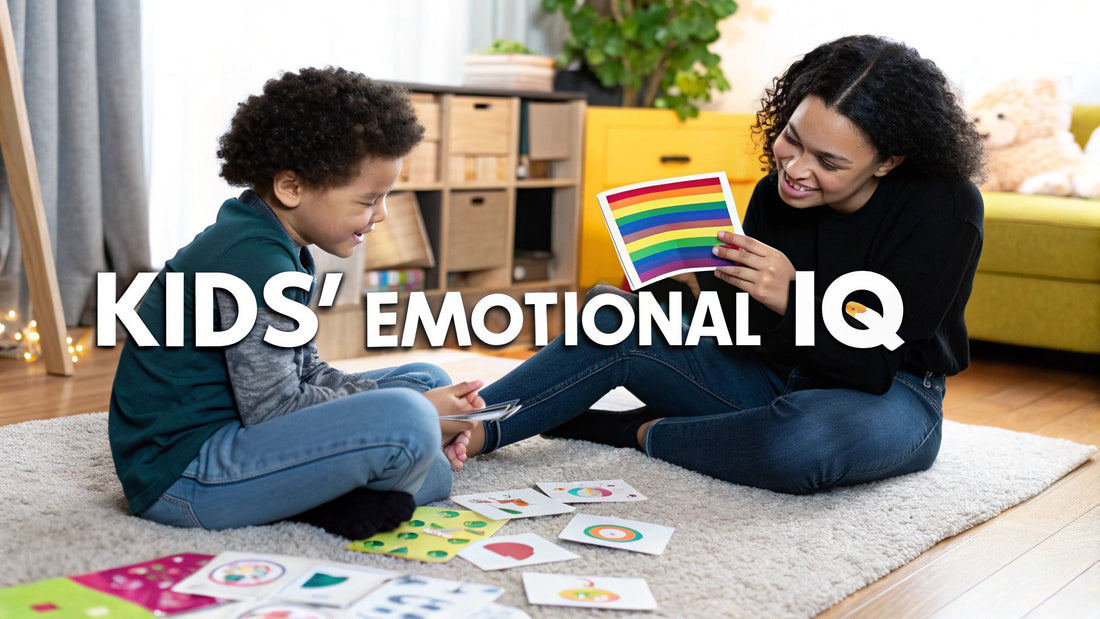
Teaching Kids Emotional Intelligence: A Practical Guide
Share
Teaching kids about emotional intelligence is about giving them the tools to understand their own feelings, show empathy for others, and handle their reactions in a healthy way. Think of it as a foundational skill for navigating life's ups and downs, especially in the complex world we live in now. This guide is all about practical, supportive advice to help you nurture this crucial ability in your children.
Why Emotional Intelligence Is So Important for Today's Kids
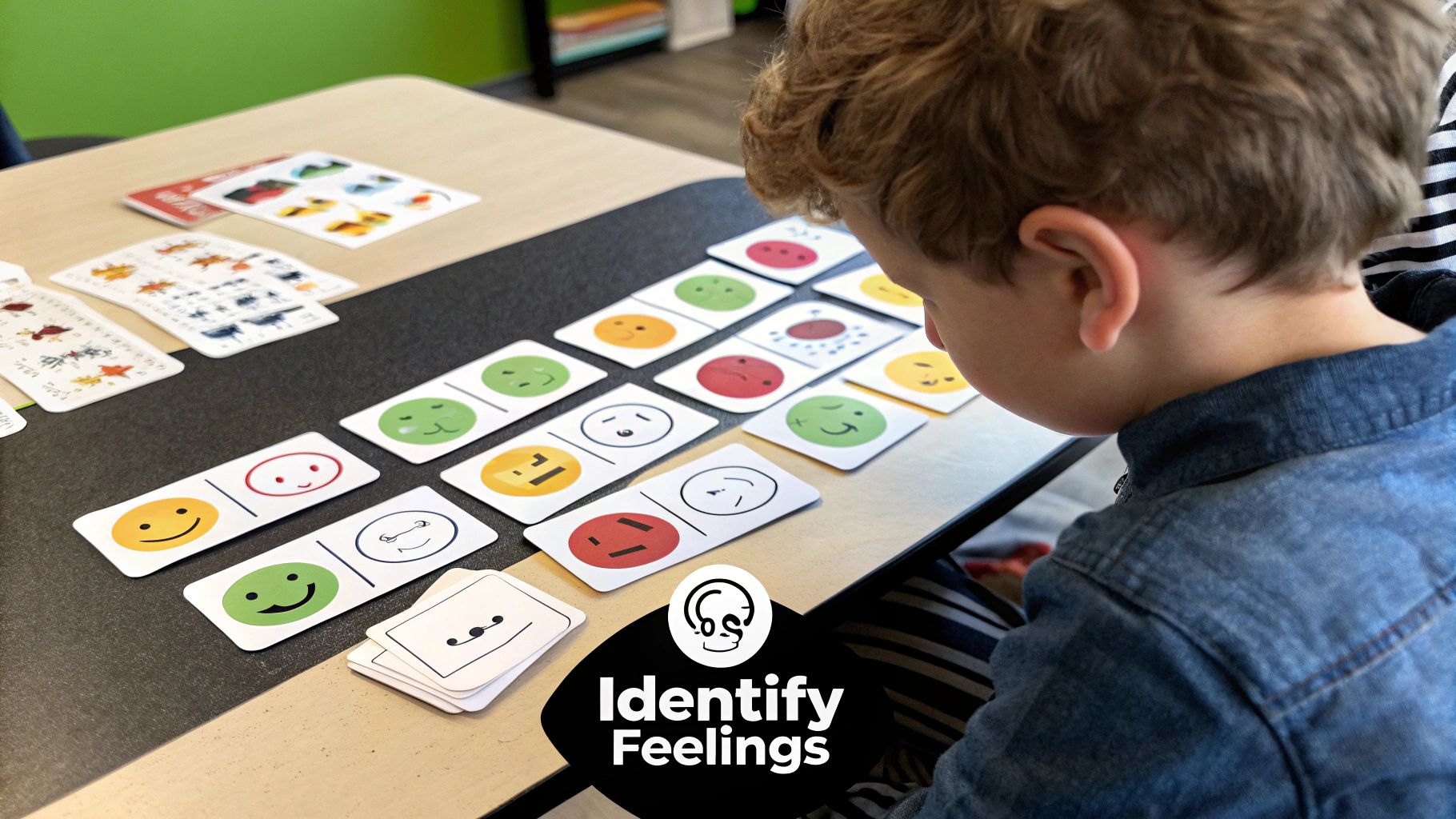
Let's be honest—raising resilient children today feels more complicated than ever. Between the pressures of social media and the ongoing social adjustments post-pandemic, children in the UK are facing a unique set of challenges. A strong emotional foundation isn't just a 'nice-to-have' any more; it's an essential part of their toolkit for a happy, well-adjusted life.
Teaching emotional intelligence isn't about shielding them from difficult feelings. Quite the opposite, really. It’s about equipping them with the awareness and skills to process those big emotions constructively.
The Growing Focus on Children's Mental Health
The conversation around mental health has thankfully become much more open, and its importance for children is finally in the spotlight. Research consistently shows that a child's emotional wellbeing is a powerful predictor of their future success and happiness—even more so than their IQ.
Sadly, the statistics paint a worrying picture. It's estimated that one in five children in the UK has a probable mental health problem. This reality really underscores the urgent need for proactive support, both at home and in schools. The impact of neglecting this foundation is significant; poor mental health costs UK businesses between £53 and £56 billion every year, a cycle that often begins with the coping skills we fail to learn in childhood.
If you're looking to build your own skills in this area, you can also explore general strategies to increase emotional intelligence and apply those lessons within the family.
The Impact of Social Media and Modern Pressures
The digital world adds another layer of complexity. While it can offer connection, it also creates an environment ripe for comparison and anxiety. Children are often exposed to curated, unrealistic versions of life, which can really knock their self-esteem and emotional regulation. This constant exposure can contribute to a rise in anxiety and body image issues, making emotional resilience more vital than ever.
Fostering emotional intelligence provides a crucial counterbalance. It helps children develop a stronger sense of self, build genuine connections, and navigate online interactions with greater empathy and resilience.
A Note on Professional Advice
It’s important for me to state that I am not a mental health professional. This guide is designed to offer practical, supportive advice from one parent to another, based on established principles of emotional development.
If you have serious concerns about your child's mental health, please speak with your GP or a qualified professional. They can provide the expert guidance and support your family needs. Building a strong emotional foundation at home is a powerful step, but it works best alongside professional help when it's needed.
Building Your Child's Emotional Vocabulary
Before a child can manage a big feeling, they need to be able to name it. This is really the first, most fundamental step in nurturing emotional intelligence – giving them the words to make sense of their inner world. Think of it as building a library of feelings; the more words they have, the better they can understand themselves and others.
It all starts very simply. With my own toddler, I'd point to a character in a book and say something like, "Look, the bear seems frustrated that his tower fell down." It’s a tiny moment, but it connects a word, a feeling, and a situation. That’s a powerful learning connection.
As they get older, the goal is to move past the basic emotions like 'sad' or 'angry'. We want to introduce them to a richer, more specific vocabulary. Words like 'disappointed', 'anxious', 'embarrassed', and 'overwhelmed' give them the tools to express exactly what’s going on inside with much more precision.
Why Naming Feelings Matters
Just putting a label on an emotion can be incredibly powerful. It takes a big, scary, internal feeling and makes it something separate and manageable. When you help your child find the right word, you're not just expanding their vocabulary; you're handing them a core skill for self-regulation.
And this goes way beyond just managing tantrums. Children's mental health is a growing concern, and building emotional literacy from a young age is one of the best preventative tools we have. It equips the next generation to better navigate life's inevitable ups and downs.
A child who can say, "I feel disappointed because the party was cancelled," is in a much better position to cope than a child who can only act out their frustration. Naming the feeling is the first step towards taming it.
Practical Ways to Expand Their Emotional Language
Weaving this into daily life is easier than you might think. It’s all about becoming an "emotion coach" in everyday moments, turning potential flare-ups into opportunities for connection and learning.
-
Narrate Your Own Feelings: Model how it’s done by talking about your own feelings in a simple, age-appropriate way. For example, "I'm feeling a bit overwhelmed by all this noise, so I'm going to sit quietly for a minute."
-
Use Books and Media: Chat about the feelings of characters in stories, films, or TV shows. Ask open-ended questions like, "How do you think they felt when that happened?" or "What do you think made them feel so angry?" There are some wonderful mental health books out there designed specifically to help children explore these ideas.
-
Turn Meltdowns into Teachable Moments: When your child is upset over a broken toy, try to validate their feeling first, before jumping in to fix it. You could say, "I can see you're feeling really let down that your favourite car is broken. That's a tough feeling."
You’ll start to see how developing these skills impacts a child’s whole world. This chart gives a great visual of how emotional intelligence influences key areas of their development.
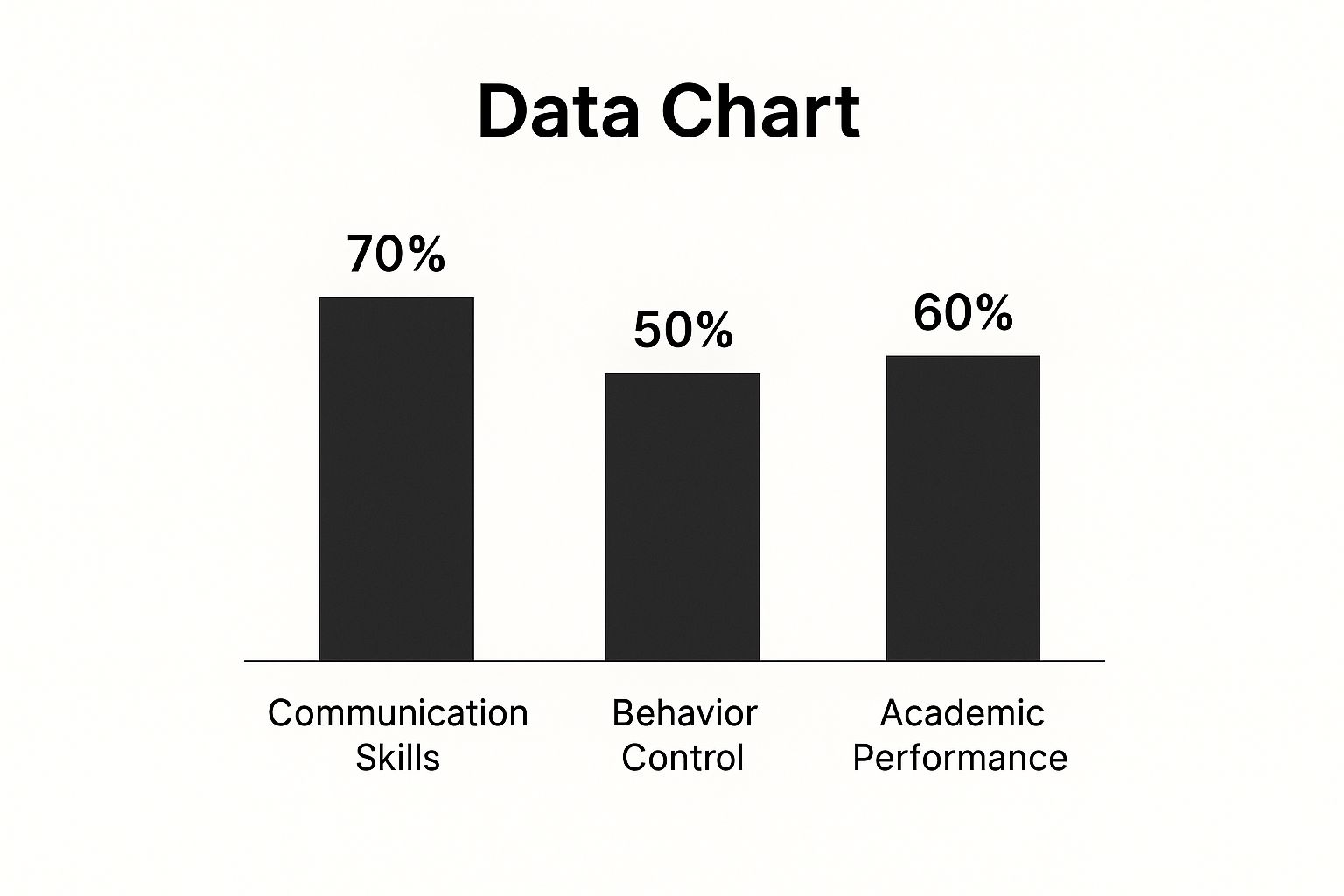
As the infographic shows, a well-developed emotional vocabulary directly supports better communication, improved behaviour, and even stronger academic performance.
From Basic to Nuanced Words
To help you get started, I’ve put together a simple guide for introducing more nuanced emotion words. The goal is to make this a natural part of how your family talks about feelings.
Expanding Your Child's Emotional Vocabulary
Moving beyond the basics can open up a whole new level of understanding and communication. Here are a few simple swaps you can try in your everyday conversations.
| Instead of... | Try introducing... | Example sentence to use |
|---|---|---|
| Sad | Disappointed, Lonely, Hurt | "It sounds like you feel disappointed that we can't go to the park." |
| Happy | Proud, Excited, Content | "You look so proud of yourself for finishing that big puzzle!" |
| Angry | Frustrated, Annoyed, Cross | "I can see you're getting frustrated because your shoelaces won't tie." |
| Scared | Anxious, Worried, Nervous | "It's normal to feel nervous before your first day at a new club." |
Using these more specific words gives children a clearer map of their emotional landscape, helping them navigate it with more confidence as they grow.
Please remember, I am not a mental health professional. The advice here is for guidance and support. If you are ever worried about your child's emotional wellbeing, please seek help from your doctor or a qualified expert.
How to Nurture Genuine Empathy
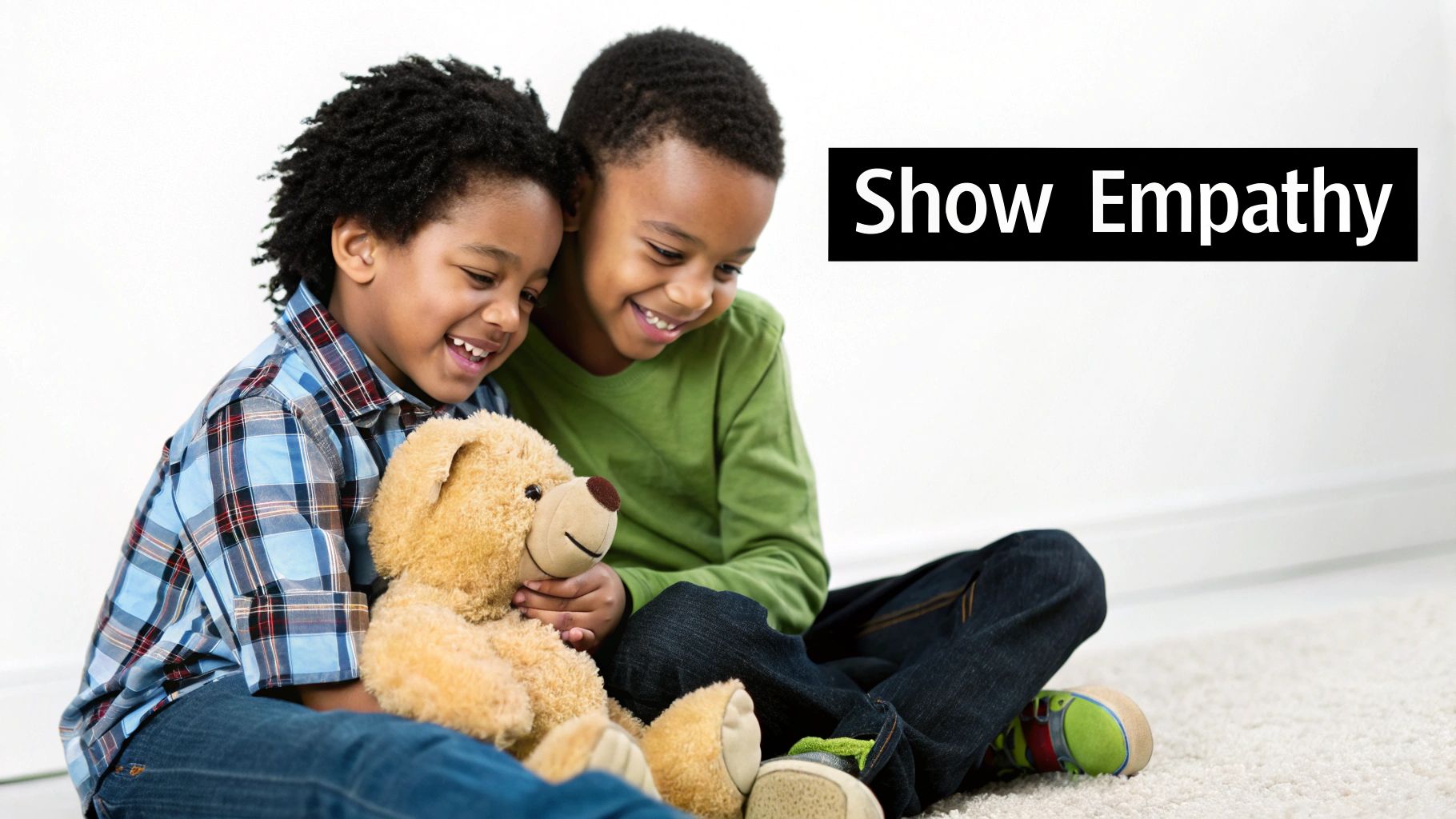
Once your child starts getting the hang of naming their own feelings, the next piece of the puzzle is learning to spot those same feelings in other people. This is empathy, pure and simple: the incredible ability to step into someone else’s shoes and try to see the world from where they’re standing.
Fostering real empathy is, I think, one of the most powerful things we can do to help our kids grow into well-rounded, compassionate people.
It all starts in those small, everyday moments. You could gently ask things like, "How do you think Maya felt when you shared your snack with her?" or "I noticed your friend was really quiet today. I wonder if everything is okay?" The point isn't to get a 'right' answer, but just to get them thinking beyond their own little world.
Modelling Empathy in Your Own Life
Our kids are always watching. They learn so much more from what we do than what we say. When you show empathy towards them, your partner, friends, or even strangers in the supermarket, you’re giving them a real-life lesson they’ll never forget.
When your child is upset, try listening and validating their feelings before anything else. Something as simple as, "It sounds like you're feeling really left out right now, and that must be tough," shows them you see them and you understand. That right there is empathy in action.
You can also model this in how you talk about others. For example, after seeing someone lose their temper, you could later say, "That person seemed very cross in the shop. I wonder if they're having a difficult day?" This tiny shift in perspective teaches children to look for the story behind the behaviour.
Using Stories to Build Perspective
Books and films are fantastic tools for building empathy. They’re like a safe little laboratory where children can explore tricky social situations and see things from different points of view.
Next time you’re reading a book or watching a film together, press pause and have a little chat about what the characters might be feeling.
- Ask curious questions: "Why do you think the dragon was so grumpy at the start of the story?"
- Explore their reasons: "What do you think made the princess change her mind?"
- Think about the impact: "How did what he did make the other characters feel?"
This helps your child connect the dots between actions and emotions, building their capacity for compassion. For more on this, you might find our guide on teaching emotional awareness to children helpful.
Navigating Empathy in the Digital Age
Social media throws a real spanner in the works when it comes to empathy. The distance of a screen can make it so easy to forget there’s a real person, with real feelings, on the other side. This is particularly concerning as cyberbullying and online negativity can have a severe impact on a young person’s mental wellbeing.
It's so important to have open conversations about being kind online. We need to teach our children that the words they type have a real impact. A great habit is to encourage them to pause before they post or comment and ask themselves: "Is this kind? Is it helpful? How would I feel if someone said this to me?"
The impact of online interactions on mental health is huge. By teaching digital empathy, you give your child the tools to be a responsible and kind digital citizen, which protects their own wellbeing and that of others.
When we nurture empathy, we’re doing more than just teaching our children to be nice. We’re giving them a fundamental life skill that will strengthen their friendships, help them in their future careers, and ultimately, allow them to become more connected and compassionate human beings.
As always, please remember that I am not a mental health professional. If you have concerns about your child's wellbeing, it is always best to consult your GP or a qualified expert for guidance.
Practical Ways to Manage Big Feelings
Every child, at some point, gets completely floored by a big, overwhelming emotion. It could be that fiery frustration when a toy won’t cooperate, or the quiet, creeping worry that keeps them staring at the ceiling at night.
Our first instinct might be to just say "calm down," but without the right tools, that’s like telling someone to build a house without giving them any bricks. This section is your practical toolkit for helping them navigate these emotional storms.
The goal isn't to stop the feelings from happening—that’s impossible, and it's not healthy anyway. It's about empowering your child with their own coping mechanisms so they feel more in control when those big feelings inevitably strike.
With the rising rates of childhood mental health challenges in the UK, these skills are more essential than ever. Teaching children how to manage their emotions proactively is a powerful form of preventative care for their wellbeing. It’s a skill that has a ripple effect, even impacting the economy; poor mental health costs UK businesses billions annually in lost productivity, a cycle that often begins with the coping skills we learn (or don't learn) in childhood.
Create a Calm-Down Corner
One of the most effective strategies I've seen is creating a dedicated safe space in your home. This isn't a 'naughty step' or a place for punishment. Not at all. It’s a cosy, inviting spot where your child can choose to go to feel safe and regulate their emotions when they feel overwhelmed.
You can create this space together, which gives them a real sense of ownership over it.
- Choose a quiet spot: A little nook in their bedroom or a corner of the living room with a few cushions works perfectly.
- Fill it with soothing items: Think soft blankets, a favourite teddy, sensory toys like squishy balls or fidget spinners, and maybe some calming books.
- Introduce it during a calm moment: Explain that this is their special place to go whenever they feel sad, angry, or worried and just need a moment to themselves.
The whole idea is to build a positive association with the space. It’s a retreat, not an exile.
Introduce Simple Relaxation Techniques
When a child is in the grip of a strong emotion, their body is in a state of high alert. Simple, physical relaxation techniques can help bring their nervous system back into balance. These are tools you can practise together when everyone is calm, so they become second nature during stressful moments.
The impact of modern life, particularly the constant stimulation from social media, can make it much harder for children's nervous systems to switch off. Teaching them intentional relaxation techniques gives them a vital counterbalance to these pressures.
Progressive Muscle Relaxation
This is a wonderful way to physically release tension. Ask your child to lie down and tense their toes for five seconds, then relax them completely. Work your way up the body: tense and release their legs, tummy, hands, and shoulders. It helps them feel the difference between tension and relaxation.
Another brilliant exercise is 'box breathing'—inhale for a count of four, hold for four, exhale for four, and hold for four again. You can even trace a square in the air with your finger as you do it together.
Talk It Through After the Storm
Let's be clear: the time for problem-solving is never in the middle of an emotional hurricane. Once the big feelings have passed and your child is calm again, that’s your window of opportunity for a valuable lesson.
Sit down with them and talk gently about what happened. You might say, "That was a really big feeling of anger you had earlier. What do you think was going on inside?" This helps them connect their behaviour to the underlying emotion, which is a crucial step in learning how to manage it next time. For more tips on this, discover 4 things you can do to support your child's mental health in our related article.
You can also use this time to explore better ways to handle the situation in the future. It’s about turning a tough moment into a constructive, supportive learning experience.
Please remember, I am not a mental health professional. This advice is intended for support and guidance. If you are worried about your child's mental health, it is always best to seek help from your GP or a qualified expert.
Applying EQ in School and Friendships
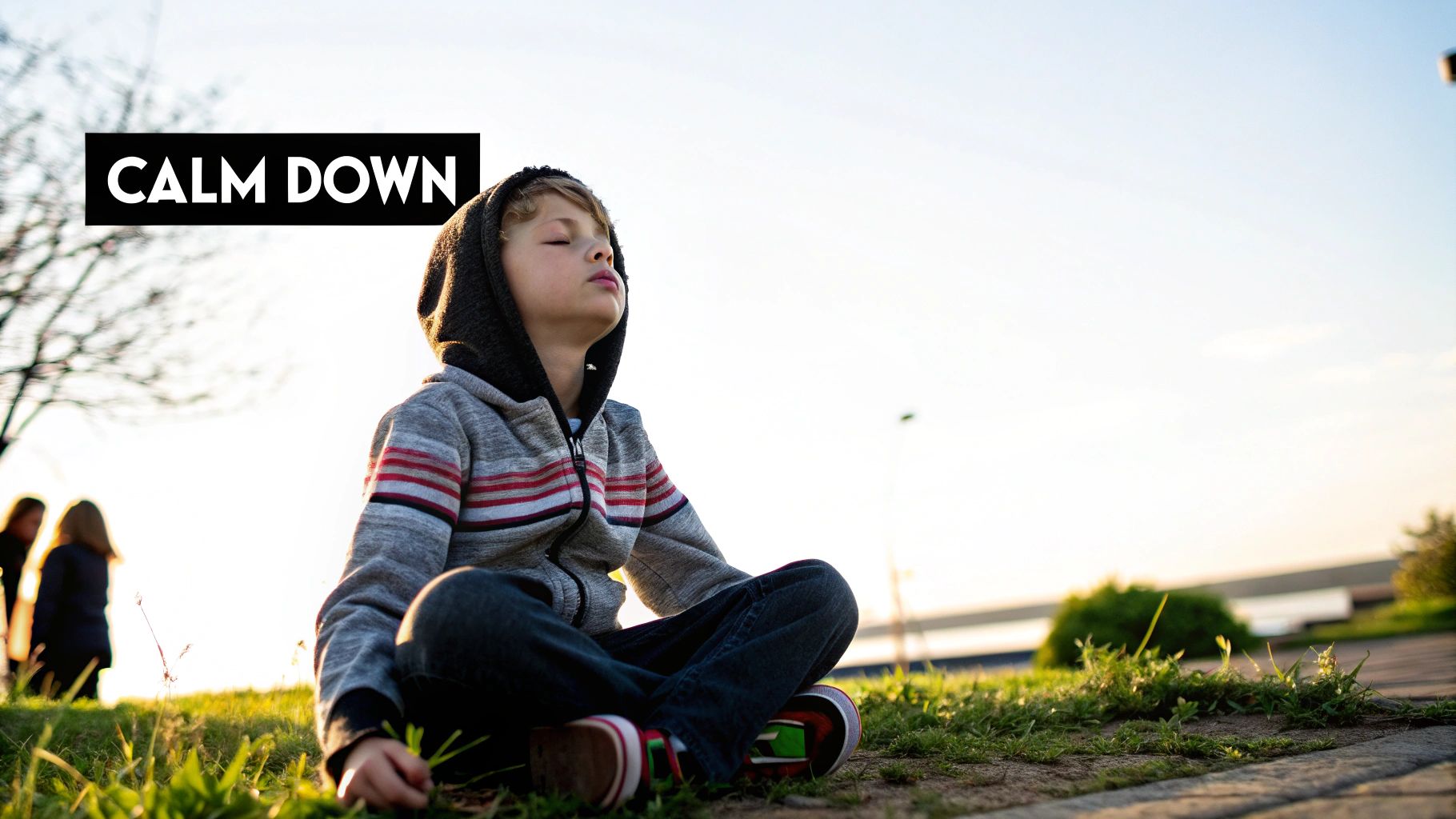
This is where the rubber meets the road. All those conversations and activities at home are the foundation, but the real test of emotional intelligence happens on the playground, in the classroom, and during exam season.
Our job is to equip our children for these very real challenges, from navigating the choppy waters of friendship fallouts to standing firm against peer pressure. Think of it as moving from theory to practice. At home, you can create a safe space to talk through tricky scenarios. This builds the confidence they need to handle these situations when you’re not there to guide them.
Navigating Playground Politics and Peer Pressure
Friendship dynamics can be a real minefield for children. One day they're inseparable, the next they're not even speaking. Helping your child make sense of these ups and downs is a massive part of supporting their social well-being.
When they come home upset about a friend, the first and most important thing you can do is listen. Really listen. Resist that powerful urge to jump in and fix it for them. Instead, try asking open-ended questions like, "That sounds really tricky. How did that make you feel?" or "What do you think might happen next?"
Role-playing is also a brilliant tool. You can practise saying "no" to a friend who is pushing them to do something they’re not comfortable with. For instance, you could pretend to be the friend and say, "Go on, just have a look at this website, everyone else is." Then help your child find the words to respond, like, "No thanks, I don't feel comfortable with that." This gives them a chance to find the right words in a low-stakes environment.
Tackling Academic Stress and Building Resilience
The pressure on children to perform at school is a huge concern for many UK families, especially around exam time. This is when stress and anxiety can really spiral. The challenges of exam stress are a stark reminder of why teaching emotional intelligence is so important.
A 2023 survey by Parentkind revealed that 70% of parents are worried about their child's mental health due to the pressure of exams. This highlights just how important it is to address the issue of academic stress head-on.
These pressures make it absolutely vital that we equip our children with emotional coping strategies. Resilience isn't about never feeling stressed; it's about knowing how to manage that stress in a healthy way.
One of the best ways to help is by shifting the focus from the final result to the effort they put in. Praise their hard work, their perseverance, and their courage to try, not just the mark they get. This helps to build a growth mindset and takes the sting out of the fear of failure. It's also a perfect opportunity to introduce a few simple relaxation techniques.
Practical Relaxation Tips for Exam Nerves
When stress takes over, a child’s body flips into fight-or-flight mode. Simple physical exercises can help bring them back to a calmer state.
- Deep Belly Breaths: Teach them to pop a hand on their tummy and take slow, deep breaths. They should feel their hand rise and fall. It’s a simple action that can physically lower their heart rate.
- A Mindful Moment: Encourage them to take a 60-second break just to notice their surroundings. What can they see, hear, and feel right now? This grounds them in the present.
- Positive Self-Talk: Help them come up with a simple, encouraging phrase they can repeat to themselves. Something like, "I've worked hard and I can do this."
Remember, if you are ever seriously worried about your child's mental health, it is vital to speak with your GP or a qualified professional. You are not alone, and expert help is available.
By focusing on these practical strategies, you empower your child to build the emotional strength they need to thrive, both at school and with their friends. These are foundational skills that will support their overall wellbeing for years to come. For more ideas, you might find these mental health activities for 2025 helpful.
Your Top Questions About Emotional Intelligence
As you start this journey of teaching kids about their big feelings, it’s completely normal for questions to bubble up. This is a marathon, not a sprint, and it's okay to feel a bit unsure sometimes. I’ve put together some straightforward answers to the queries I hear most often, hopefully giving you a bit more clarity and confidence.
Why Is My Child's Mental Health So Important?
Looking after your child's mental health is, without a doubt, one of the most vital parts of parenting. It's a shocking statistic, but in the UK, it's estimated that one in five children have a probable mental health problem. Good mental health is the very foundation on which a happy, successful life is built.
When children learn to recognise and handle their emotions, they build resilience. This is the superpower that helps them bounce back from life's inevitable knocks, from a tiff in the playground to the stress of exams. If we neglect this foundation, the consequences can ripple out for years, not just for them but for society as a whole.
Just think about it: poor mental health in the workforce costs UK businesses a staggering £53-£56 billion each year. Many of these issues have their roots in childhood, which really brings home just how crucial early emotional education is.
How Does Social Media Affect Their Emotional Wellbeing?
Social media is a huge part of modern life, there’s no getting away from it. But it can have a massive impact on a child's mental health. The endless scroll through curated, picture-perfect lives can easily lead to feelings of inadequacy, anxiety, and a hit to their self-esteem.
It’s so important to have open, honest conversations about the online world. We need to teach them that what they see on their screens is often just a highlights reel, not the full, messy reality of someone's life. Encourage them to notice how scrolling actually makes them feel and to step away when it starts to feel draining.
Fostering strong emotional intelligence gives your child a vital buffer against the negative pressures of social media. It helps them build a solid sense of self-worth that isn’t tied to likes or follows.
Can You Suggest Some Simple Relaxation Tips for Kids?
Absolutely. When a child is feeling completely overwhelmed, a few simple physical actions can make a world of difference. The trick is to practise these techniques together when things are calm, so they become second nature when stress levels are running high.
- Mindful Listening: Ask your child to close their eyes for just one minute and tell you all the different sounds they can hear, both close by and far away. It’s a simple exercise that pulls their focus from anxious thoughts and grounds them in the present moment.
- Progressive Muscle Relaxation: Get them to lie down comfortably. Ask them to tense up a muscle group (like making tight fists) for five seconds, and then release it completely. You can work your way through different parts of the body, from toes right up to their shoulders. It's a great way to physically let go of tension.
- 'Worry Time': This one sounds odd, but it works. Schedule a specific, short slot (maybe 10 minutes after school) just to talk about worries. This helps to contain the anxiety, rather than letting it spill over and take over their entire day.
Are There Any Good Books or Resources You Recommend?
Reading together is a fantastic way to open up conversations about feelings. Look for stories that explore different emotions and tricky social situations. There are so many wonderful mental health books for children out there that can help them make sense of complex feelings in a way they can understand.
On top of that, some brands offer things like clothing with positive mental health messages. Popping on a T-shirt or hoodie with an encouraging slogan can be a simple, visible reminder to be kind to yourself and helps make conversations around mental wellbeing feel more normal.
When Is It Time to Seek Professional Help?
This is such an important question, and my first piece of advice is to always trust your gut. While this guide is here to offer support, I am not a mental health professional. It is absolutely vital to seek expert advice if you have serious concerns about your child.
It’s time to speak to a doctor if you notice persistent changes that are disrupting your child's daily life.
Look out for things like:
- Long periods of sadness, irritability, or withdrawing from family and friends.
- Significant changes in their sleeping or eating habits.
- Losing interest in activities they used to absolutely love.
- Intense anxiety that stops them from going to school or seeing their friends.
Your GP is the best first port of call. They can listen without judgement and point you towards the right specialist services, making sure your child gets the expert support they need.
At Little Fish Books, we believe that nurturing a child’s emotional world is the greatest gift we can give them. From beautifully illustrated books that spark important conversations to engaging activities that build resilience, our resources are designed to support you and your child on this vital journey. Explore our collection and find the perfect tools to help your little one thrive.
Visit us at https://thatsokay.co.uk to learn more.
